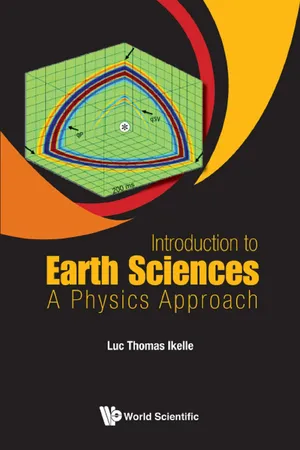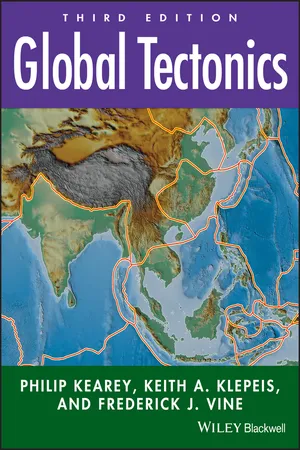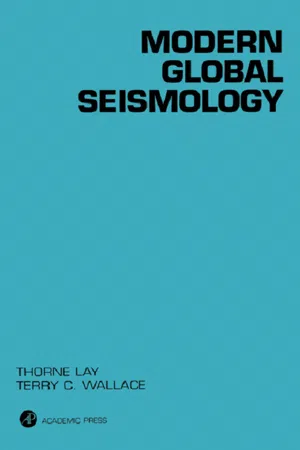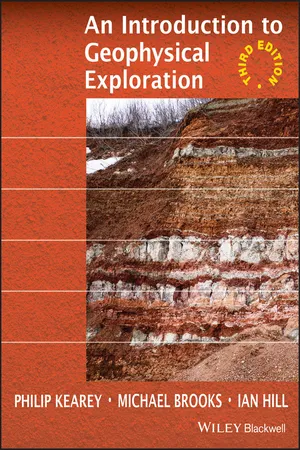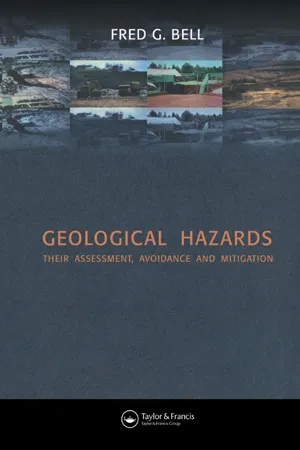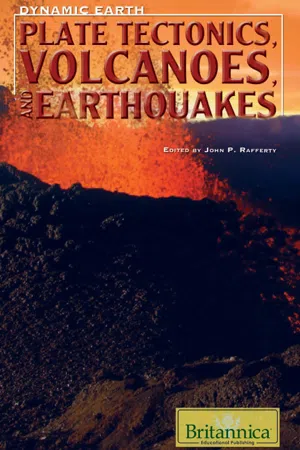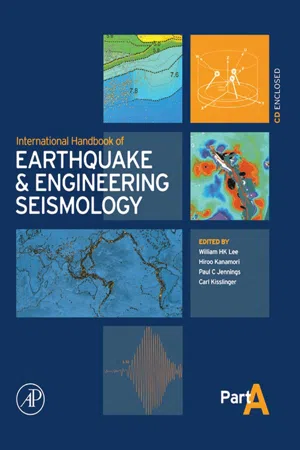Physics
Seismic Waves
Seismic waves are vibrations that travel through the Earth as a result of sudden energy release, such as from an earthquake or explosion. They can be classified into two main types: body waves, which travel through the Earth's interior, and surface waves, which travel along the Earth's surface. These waves provide valuable information about the Earth's interior and are used in seismology to study earthquakes and the structure of the Earth.
Written by Perlego with AI-assistance
11 Key excerpts on "Seismic Waves"
- eBook - ePub
Introduction to Earth Sciences
A Physics Approach
- Luc Thomas Ikelle(Author)
- 2017(Publication Date)
- WSPC(Publisher)
Part A
Earthquake and Volcanoes
Passage contains an image
Chapter 2: Seismic Waves and Evidences of Earth’s Interior Structure
1.Seismic Waves 1.1.Wave propagation and seismic data 1.2.Body waves: P- and S-waves 1.3.Reflection, refraction, transmission, and diffraction 1.4.Surface waves: Love and Raleigh waves 2.EARTH’S INTERIOR: EVIDENCE 2.1.The crust/mantle boundary 2.2.The mantle/core boundary: the P-wave and S-wave shadowed zones 2.3.The outer-core/inner-core boundary 2.4.Scientific drilling programsHow can scientists — more precisely geophysicists and geochemists — find out what is happening deep inside the earth? The temperatures are too high, the pressures are extreme, and the distances are too vast for drilling (see Figure 1.8 ). How did geophysicists determine that the mantle is solid, the outer core is liquid, and the inner core is solid? To do so, scientists relied on Seismic Waves (elastic waves) — waves generated by earthquakes and explosions that travel through the earth and across its surface to reveal the structure of the interior of the planet. Thousands of earthquakes occur every year, and each one provides a glimpse of the earth’s interior.Seismic signals associated with these earthquakes consist of several kinds of waves. Those important for understanding the earth’s interior are P-waves (also known as primary waves, compressional waves, or longitudinal waves) and S-waves (also known as secondary or shear waves), which travel through solid, liquid, and gaseous materials in different ways. There are also surface waves. Our objective in this chapter is to introduce Seismic Waves and describe how these waves allow us to understand the solid earth’s interior.1Seismic Waves
1.1Wave propagation and seismic data
There is nothing more important in the education of geophysicists than developing their understanding of and intuition about how Seismic Waves propagate in the ground. Suppose that you are in a dark room in the library, surrounded by a multitude of books. You are looking for a particular book. You will need a flashlight to guide you to the specific row and column where you can locate this desired book. The problem of exploring solid earth is quite similar. We are trying to see through a dark and compact Earth, and Seismic Waves are one of the flashlights which help us to see beneath the earth’s surface. So we start this section by describing wave propagation. - eBook - ePub
- Philip Kearey, Keith A. Klepeis, Frederick J. Vine(Authors)
- 2013(Publication Date)
- Wiley-Blackwell(Publisher)
2 The interior of the Earth2.1 EARTHQUAKE SEISMOLOGY
2.1.1 Introduction
Much of our knowledge of the internal constitution of the Earth has come from the study of the Seismic Waves generated by earthquakes. These waves follow various paths through the interior of the Earth, and by measuring their travel times to different locations around the globe it is possible to determine its large-scale layering. It is also possible to make inferences about the physical properties of these layers from a consideration of the velocities with which they transmit the Seismic Waves.2.1.2 Earthquake descriptors
Earthquakes are normally assumed to originate from a single point known as the focus or hypocenter (Fig. 2.1 ), which is invariably within about 700 km of the surface. In reality, however, most earthquakes are generated by movement along a fault plane, so the focal region may extend for several kilometers. The point on the Earth’s surface vertically above the focus is the epicenter. The angle subtended at the center of the Earth by the epicenter and the point at which the Seismic Waves are detected is known as the epicentral angle Δ. The magnitude of an earthquake is a measure of its energy release on a logarithmic scale; a change in magnitude of one on the Richter scale implies a 30-fold increase in energy release (Stein & Wysession, 2003).Illustration of epicentral angle Δ .Figure 2.12.1.3 Seismic Waves
The strain energy released by an earthquake is transmitted through the Earth by several types of seismic wave (Fig. 2.2 ), which propagate by elastic deformation of the rock through which they travel. Waves penetrating the interior of the Earth are known as body waves , and consist of two types corresponding to the two possible ways of deforming a solid medium. P waves , also known as longitudinal or compressional waves, correspond to elastic deformation by compression/dilation. They cause the particles of the transmitting rock to oscillate in the direction of travel of the wave so that the disturbance proceeds as a series of compressions and rarefactions. The velocity of a P waveVp - Robin Spence, Emily So(Authors)
- 2021(Publication Date)
- Wiley-Blackwell(Publisher)
2020a ). As the seismograph shakes, the recording device on the mass records the relative motion between itself and the rest of the instrument, thus recording the ground motion. These mechanisms are no longer manual but are measured using electronic changes produced by the motion of the ground with respect to the mass. A seismogram is the recording of the ground shaking at the specific location of the instrument and tells us the size of the event, with time on its horizontal axis and ground displacement on its vertical axis.There are four main types of earthquake waves: P‐waves and S‐waves (which are body waves), and Rayleigh waves and Love waves (which are surface waves). Body waves can travel through the Earth's interior, whereas surface waves can only move along the surface of the earth like ripples on water. Travelling only through the crust, surface waves are of a lower frequency than body waves and are easily distinguished on a seismogram as a result. Though they arrive after body waves, it is surface waves that are almost entirely responsible for the damage and destruction associated with earthquakes. Love waves tend to cause the most damage due to their large amplitude. The damage and strength of the surface waves are reduced in deeper earthquakes.The fastest waves are the P‐waves. P‐waves also referred to as primary or compressional waves can move through solids, liquids and gases. A P‐wave pushes and pulls the rock, it moves through just like sound waves push and pull the air. These are used by seismologists to locate the earthquakes, and they travel at a speed of about 5–8 km/s. S‐waves travel more slowly than the P‐waves and can only travel through solids, at about 3–5 km/s. The crucial difference in arrival times between P and S waves is sometimes used as a short‐term earthquake alert; for example, it is used to automatically stop all Shinkansen trains in Japan ahead of the more damaging S‐waves.- eBook - ePub
- Thorne Lay, Terry C. Wallace(Authors)
- 1995(Publication Date)
- Academic Press(Publisher)
International Geophysics , Vol. 58, Suppl. (C), 1995ISSN: 0074-6142doi: 10.1016/S0074-6142(05)80003-8Chapter 2 Elasticity and Seismic WavesSeismology involves analysis of ground motions produced by energy sources within the Earth, such as earthquake faulting or explosions. Except in the immediate vicinity of the source, most of the ground motion is ephemeral; the ground returns to its initial position after the transient motions have subsided. Vibrations of this type involve small elastic deformations, or strains , in response to internal forces in the rock, or stresses. The theory of elasticity provides mathematical relationships between the stresses and strains in the medium, and it has spawned a vast literature filled with theory and empirical documentation of elastic behavior. Here we develop only the basics of the theory of elasticity required for seismological applications, including the concepts of strain and stress, the equations of equilibrium and motion, and the fundamental nature of solutions to the equations of motion: Seismic Waves. Chapters 3 and 4 characterize wave interactions relevant to Seismic Waves in the Earth, and subsequent chapters apply these basic ideas to describe how seismologists study the Earth’s interior and the sources of Seismic Waves.Our development of elasticity follows that typical of texts on solid mechanics, and many more detailed discussions are available, some being listed in the References. In the study of solids, a useful, idealized concept for dealing with macroscopic phenomena is that of a continuum , in which matter is viewed as being continuously distributed in space. Within this continuous material we can define mathematical functions for displacement, strain, or stress fields, which have well-defined continuous spatial derivatives. We will see that applying simple laws of physics to a continuum (continuum mechanics - eBook - ePub
- Philip Kearey, Michael Brooks, Ian Hill(Authors)
- 2013(Publication Date)
- Wiley-Blackwell(Publisher)
Seismic surveying was first carried out in the early 1920s. It represented a natural development of the already long-established methods of earthquake seismology in which the travel times of earthquake waves recorded at seismological observatories are used to derive information on the internal structure of the Earth. Earthquake seismology provides information on the gross internal layering of the Earth, and measurement of the velocity of earthquake waves through the various Earth layers provides information about their physical properties and composition. In the same way, but on a smaller scale, seismic surveying can provide a clear and detailed picture of subsurface geology. It undoubtedly represents the single most important geophysical surveying method in terms of the amount of survey activity and the very wide range of its applications. Many of the principles of earthquake seismology are applicable to seismic surveying. However, the latter is concerned solely with the structure of the Earth down to tens of kilometres at most and uses artificial seismic sources, such as explosions, whose location, timing and source characteristics are, unlike earthquakes, under the direct control of the geophysicist. Seismic surveying also uses specialized recording systems and associated data processing and interpretation techniques.Seismic methods are widely applied to exploration problems involving the detection and mapping of subsurface boundaries of, normally, simple geometry. They also identify significant physical properties of each subsurface unit. The methods are particularly well suited to the mapping of layered sedimentary sequences and are therefore widely used in the search for oil and gas. The methods are also used, on a smaller scale, for the mapping of near-surface sediment layers, the location of the water table and, in an engineering context, site investigation of foundation conditions including the determination of depth to bedrock. Seismic surveying can be carried out on land or at sea and is used extensively in offshore geological surveys and the exploration for offshore resources.In this chapter the fundamental physical principles on which seismic methods are based are reviewed, starting with a discussion of the nature of Seismic Waves and going on to consider their mode of propagation through the ground, with particular reference to reflection and refraction at interfaces between different rock types. To understand the different types of seismic wave that propagate through the ground away from a seismic source, some elementary concepts of stress and strain need to be considered.3.2 Stress and strain
When external forces are applied to a body, balanced internal forces are set up within it. Stress - eBook - ePub
Geological Hazards
Their Assessment, Avoidance and Mitigation
- Fred G. Bell(Author)
- 1999(Publication Date)
- CRC Press(Publisher)
Chapter 3 Earthquake activity3.1 Introduction
Although earthquakes have been reported from all parts of the world they are primarily associated with the edges of the plates that form the Earth’s crust (Figure 3.1 ). The Earth’s crust is being slowly displaced at the margins of the plates. Differential displacements give rise to elastic strains, which eventually exceed the strength of the rocks involved and faults then occur. The strained rocks rebound along the fault under the elastic stresses until the strain is partly or wholly dissipated.Earthquake foci are confined within a limited zone of the Earth, the lower boundary of which is located at approximately 700 km, and they rarely occur at the Earth’s surface. In fact, most earthquakes originate within the upper 25 km of the Earth. Because of its significance, the depth of focus has been used as the basis of a threefold classification of earthquakes: those occurring within the upper 70 km are referred to as shallow; those located between 70 and 300 km as intermediate; and those between 300 and 700 km as deep.An earthquake propagates three types of shock wave. The first pulses that are recorded are termed primary or P waves. Sometimes they are referred to as push-and-pull waves since oscillation occurs to and fro in the direction of propagation of the wave. P waves are also called compression waves or longitudinal waves. The next pulses recorded are the S waves, sometimes referred to as secondary or shake waves. These waves oscillate at right angles to the direction of propagation and usually have a larger amplitude than P waves, but the latter travel more rapidly. The third type of vibration is known as the L wave. These waves travel from the focus of the earthquake to the epicentre, immediately above at the surface, and from there they radiate over the Earth’s surface. Two types of L or surface wave can occur in a solid medium, namely, Rayleigh waves and Love waves. In the former, surface displacement occurs partly in the direction of propagation and partly in the vertical plane. They can only be generated in a uniform solid. Love waves occur in non-uniform solids and oscillate in a horizontal plane, normal to the direction of propagation. L waves are recorded after S waves. - eBook - ePub
- John Milsom, Asger Eriksen(Authors)
- 2011(Publication Date)
- Wiley(Publisher)
11 SEISMIC METHODS: GENERAL CONSIDERATIONSSeismic methods are the most effective, and the most expensive, of all the geophysical techniques used in investigating layered media. Features common to reflection and refraction surveys are discussed in this chapter. Chapter 12 is concerned with the special features of small-scale reflection work, and Chapter 13 with shallow refraction. Chapter 14 deals with the developing use of surface waves. Deep reflection surveys, which involve large field crews, bulky equipment and complex data processing, are beyond the scope of this book.11.1 Seismic WavesA seismic wave is acoustic energy (a sound wave) transmitted by vibration of rock particles. Low-energy waves are approximately elastic, leaving the rock mass unchanged by their passage, but close to a seismic source the rock may be shattered and permanently distorted.11.1.1 Types of elastic waveWhen a sound wave travels in air, the molecules oscillate backwards and forwards in the direction of energy transport. This pressure or ‘push’ wave thus travels as a series of compressions and rarefactions. In a solid medium it has the highest velocity of any of the possible wave motions and is therefore also known as the primary wave, or simply the P-wave.Particles vibrating at right angles to the direction of energy flow (which can only happen in a solid) create an S (shear , ‘shake’ or, because of its relatively slow velocity, secondary ) wave. In many consolidated rocks, the Swave velocity is roughly half the P-wave velocity. It depends slightly on the plane in which the particles vibrate but these differences are not significant in small-scale surveys.P- and S-waves are body-waves and expand within the main rock mass. Other waves, known as Love waves , are generated at interfaces, while particles at the Earth’s surface can follow elliptical paths to create Rayleigh waves . Love and Rayleigh waves may carry a considerable proportion of the source energy but travel very slowly. Traditionally they were simply lumped together as the ground roll - eBook - ePub
- R. J. Atkin, N. Fox(Authors)
- 2013(Publication Date)
- Dover Publications(Publisher)
7Elastic waves
So far we have considered problems in which the bodies are in equilibrium so that u =u (X ). An important dynamic application of the infinitesimal theory of elasticity in which u = u (X , t) is to the study of small-amplitude vibrations. The particular application of this subject upon which we concentrate here is the propagation of Seismic Waves. These waves contain information concerning the internal composition of the Earth since the energy released at the source, or ‘focus’, of an earthquake radiates in all directions, travelling through the whole of the interior of the Earth including the core. By interpreting the information received at seismological stations on the Earth’s surface, the seismologist, in effect, produces an internal picture of the Earth’s structure.Oldham (1900) identified on seismograms three main types of waves. They were (i) primary waves which are compression and expansion waves like sound waves in a gas; (ii) secondary waves arising from vibrations which are perpendicular to the direction of travel, similar in this respect to light waves; and (iii) surface waves which appear in the upper 30 km or so of the Earth’s crust. Since the first two types of wave occur within the interior of the Earth, they are called body waves . To analyse these waves mathematically, seismologists regard the Earth as a homogeneous, isotropic, elastic solid to which the infinitesimal theory of elasticity is applicable. However, in reality the Earth consists of layers of different materials, and so we include a discussion of some of the effects of these layers on wave propagation. Body force is largely insignificant, and we therefore neglect it. We also neglect the Earth’s curvature and take all surfaces to be horizontal planes; this is sufficiently accurate for earthquakes near the surface, but for deep earthquakes curvature should be considered.7.1 One-dimensional wave equation. Notion of a plane wave
- eBook - ePub
- Britannica Educational Publishing, John P Rafferty(Authors)
- 2010(Publication Date)
- Britannica Educational Publishing(Publisher)
Developing engineered structural designs that are able to resist the forces generated by Seismic Waves can be achieved either by following building codes based on hazard maps or by appropriate methods of analysis. Many countries reserve theoretical structural analyses for the larger, more costly, or critical buildings to be constructed in the most seismically active regions, while simply requiring that ordinary structures conform to local building codes. Economic realities usually determine the goal, not of preventing all damage in all earthquakes but of minimizing damage in moderate, more common earthquakes and ensuring no major collapse at the strongest intensities. An essential part of what goes into engineering decisions on design and into the development and revision of earthquake-resistant design codes is therefore seismological, involving measurement of strong Seismic Waves, field studies of intensity and damage, and the probability of earthquake occurrence.Earthquake risk can also be reduced by rapid post-earthquake response. Strong-motion accelerographs have been connected in some urban areas, such as Los Angeles, Tokyo, and Mexico City, to interactive computers. The recorded waves are correlated with seismic intensity scales and rapidly displayed graphically on regional maps via the World Wide Web.THE EXPLORATION OF EARTH’S INTERIOR WITH SEISMIC WAVESSeismological data on Earth’s deep structure come from several sources. These include P and S waves in earthquakes and nuclear explosions, the dispersion of surface waves from distant earthquakes, and vibrations of the whole Earth from large earthquakes.One of the major aims of seismology is to infer the minimum set of properties of Earth’s interior that will explain recorded seismic wave trains in detail. Notwithstanding the tremendous progress made in the exploration of Earth’s deep structure during the first half of the 20th century, realization of this goal was severely limited until the 1960s because of the laborious effort required to evaluate theoretical models and to process the large amounts of earthquake data recorded. The application of high-speed computers with their enormous storage and rapid retrieval capabilities opened the way for major advances in both theoretical work and data handling. - William H.K. Lee, Paul Jennings, Carl Kisslinger, Hiroo Kanamori(Authors)
- 2002(Publication Date)
- Academic Press(Publisher)
LR elliptically). This provides a means of identifying phase types. Third, various phases are characterized by their amplitude, period, dispersion, etc.The propagation of Seismic Waves through the Earth’s interior is governed by exact physical laws similar to the laws of light waves in optics. In general, the wave velocity increases with depth and, consequently, seismic energy follows rays that are curved with the concave side upward providing the shortest time-path through the Earth. For a spherical Earth, it is common practice to express the distance between the focus and the recorded station as the angle (denoted Δ) subtended at the center of the Earth by the arc between the source and receiver (1° ≈ 111 km).In the following discussion, we introduce several categories of seismic events. The classification is based on the distance between the event and the recording site (i.e., on the epicentral distance), which in turn governs propagation paths along which Seismic Waves travel through the Earth’s interior. Another categorization used is that according to focal depth. Earthquakes with focal depth between 0 and 70 km (about 80% of all earthquakes) are shallow-focus earthquakes. Intermediate-focus earthquakes have focal depth between 71 and 300 km. Shocks deeper than 300 km are called deep-focus earthquakes. The main reason for these classifications, which do not provide any sharp line of demarcation, is that Seismic Waves from the different categories may be discriminated from each other due to their different appearances on seismograms.There are numerous ways of classifying seismogram on the basis of epicentral distances. We will consider events recorded at distances shorter than about 1° as local events. Regional events are events recorded at distances between approximately 1° and 10°. Local and regional distance seismograms are dominated by seismic energy that has propagated through the crust and/or along the Moho discontinuity. Corresponding Seismic Waves are called crustal waves. Seismic Waves propagating through the upper mantle are recorded at distances, roughly speaking, between 10° and 30°. P and S- eBook - ePub
Petroleum Science and Technology
Petroleum Generation, Accumulation and Prospecting
- Muhammad Abdul Quddus(Author)
- 2021(Publication Date)
- CRC Press(Publisher)
Diffraction is a phenomenon in which waves are bended, spread out and cause interference between the wave forms. It occurs when a wave encounters the edges of an object or passes through an orifice. The main cause of diffraction of Seismic Waves is the non-homogeneity of the layers such as edges of faulted layers, isolated and discrete accumulation of minerals and other materials forming edges and small openings. A discontinuity in the layer structure, with a radius of curvature less than the wavelength of the seismic wave, does not obey the laws of reflection/refraction. Instead diffraction of the seismic wave takes place. Diffraction is the scattering of waves. The diffracted wave originates from underground, appears on the surface and is considered an interfering noise wave.In addition to the above-stated splitting of incidence energy and generation of various kinds of waves, there are discreet points in the rock, which encounter the seismic wave creating disturbing rays. This kind of seismic wave encounter is best stated by Huygens’s principle. The principle states that ‘every distinct and discreet point encountered in the subsurface by a seismic wave front is the source of new waves’. The new waves originating from the point, spreading around as an expanding wave sphere, are not needed in seismological studies.6.9 Seismological Survey and Technical Aspect
The seismological survey is carried out in land and marine areas. Occasionally harsh coastal and marshy land is encountered. The planning of a land survey is carried out by considering the topography of the area.Although the same principle of seismology is applied in all survey areas, the operational activities differ widely in each survey zone. The seismological survey is an involved exercise covering a broad range of activities on land or sea or harsh land in varied geographical conditions. Practically a high level of expertise and high cost are needed for carrying out the survey followed by complex processing, interpretation and modeling of the gathered data.In general the Seismic Waves are artificially created at the earth’s surface, introduced into the ground and the returning waves are monitored and recorded. Huge numbers of Seismic Waves, both genuine and interfering, are generated from the generating device as well as from the interaction of Seismic Waves with strata. Enormous wave signals are received at surface detector and recorded as ‘traced curves’ on a single sheet of paper or monitor screen. To get clear data and quality trace in the initial stage, the elimination of unwanted signals is carried out on the recording machine and seismograph. Distinct data and traces are obtained by proper automatic gain control (tuning), attenuation (reducing or elimination of spurious signals) and modulation (improving the clarity of the required signals). These electrical functions on the recording machine improve the resolution (making the trace clear and distinct), and enhance the signal/noise ratio. Final processing and improving of the data are done by computer personnel (discussed later). Here the discussion is concerned with explaining the methodology for surveying.
Index pages curate the most relevant extracts from our library of academic textbooks. They’ve been created using an in-house natural language model (NLM), each adding context and meaning to key research topics.
Explore more topic indexes
Explore more topic indexes
1 of 6
Explore more topic indexes
1 of 4
